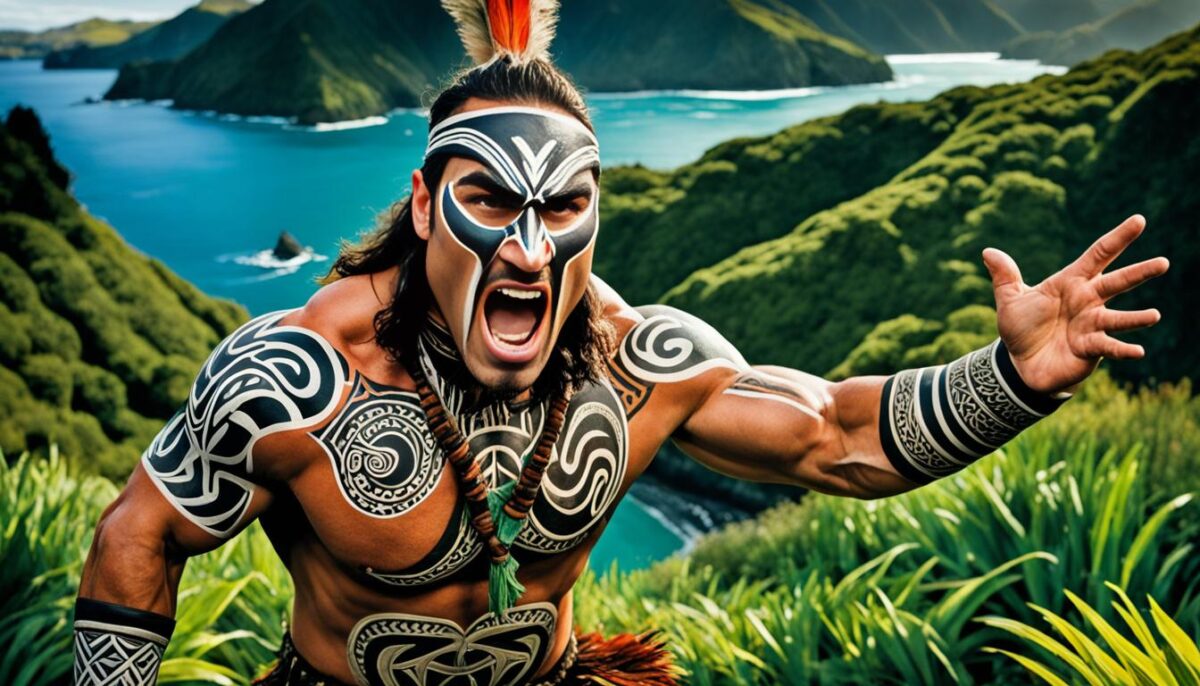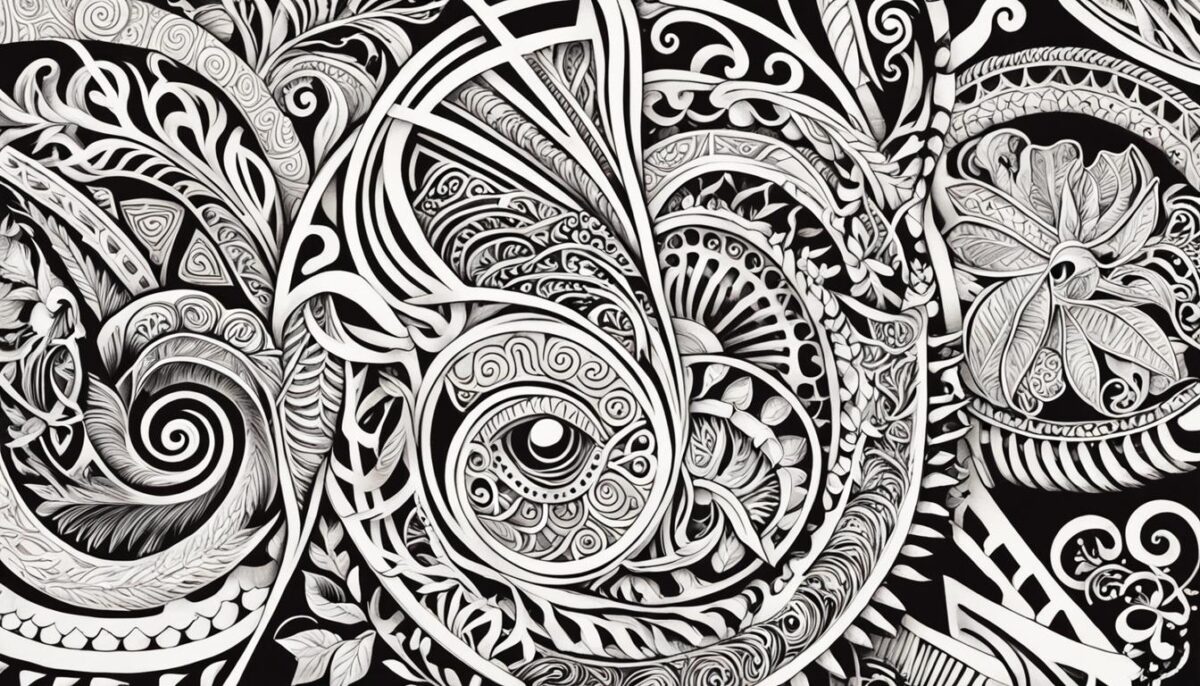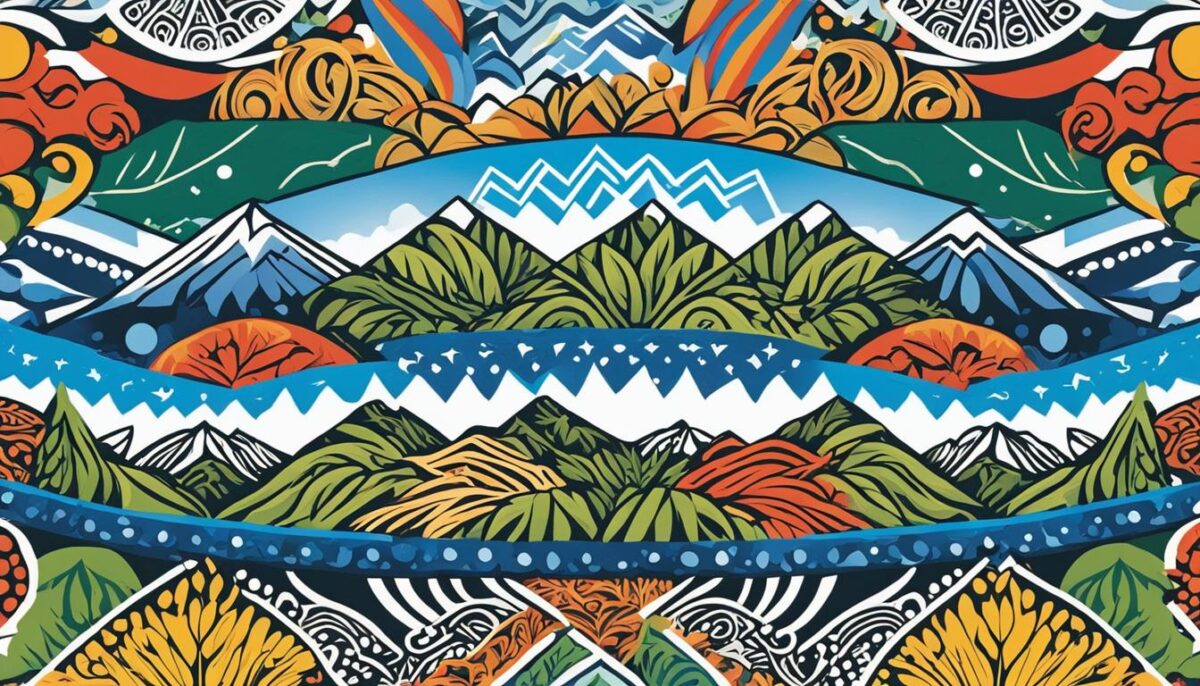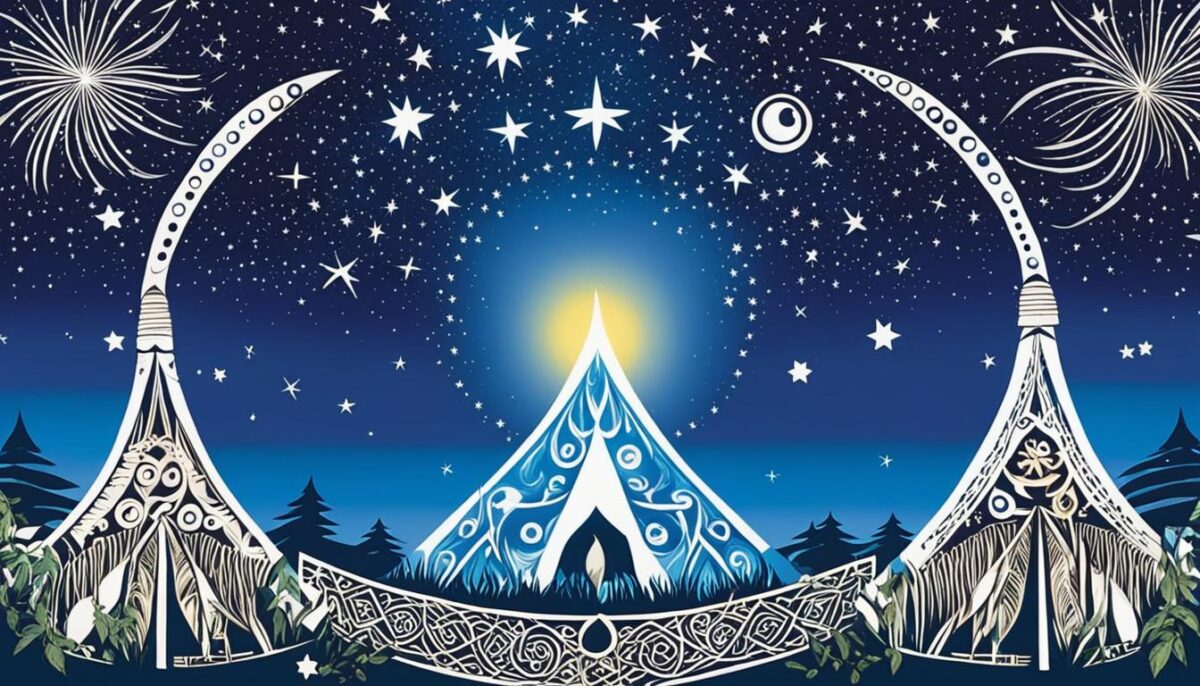In this section, we will explore the definition and background of the Maori people, who are the indigenous Polynesian population of New Zealand. The Maori have a rich heritage and vibrant culture that has played a significant role in shaping the country’s history. Understanding the Maori and their contributions is essential in appreciating New Zealand’s diverse cultural landscape.

Show a Maori warrior performing a haka, his face painted with intricate tribal markings. In the background, depict the lush greenery of New Zealand’s landscape and the pristine waters of its coast. The warrior’s stance should be strong and fierce, with his body poised for action. Use bold and contrasting colors to bring out the intensity of the scene.
Maori Culture and Traditions
In this section, we will explore the cultural aspects of the Maori people, shedding light on their unique customs, traditional practices, and artistic expressions. The Maori culture is deeply rooted in their rich heritage and serves as a testament to their vibrant identity.
Customs and Traditions
The Maori people have a diverse range of customs and traditions that have been passed down through generations. These customs encompass various aspects of daily life, such as greetings, ceremonies, and social interactions. They play a vital role in preserving Maori knowledge and identity.
“Kia ora” is a commonly used greeting in Maori culture, which translates to “be well” or “good health.” It reflects the importance of acknowledging others and creating a sense of connection.
Another significant tradition is the hongi, a traditional Maori greeting where individuals press their noses and foreheads together. It is a gesture that symbolizes the sharing of breath, creating a connection between the individuals.
Artistic Expressions
The Maori people have a rich artistic heritage that encompasses various forms of expression. These artistic expressions serve as a means of storytelling, cultural preservation, and connection to their ancestors.
“Haka” is a traditional Maori dance that has gained worldwide recognition. It combines powerful movements, chants, and facial expressions, reflecting the strength and pride of the Maori culture.
Traditional Maori tattoos, known as ta moko, are another prominent form of artistic expression. These tattoos convey individual and ancestral stories, representing an individual’s identity and connections within the community.
Weaving and carving are also integral to Maori culture. Intricate patterns and designs are woven into clothing, baskets, and mats, showcasing the mastery of traditional weaving techniques. Carvings, often found in meeting houses and canoes, depict ancestral stories and cultural symbols that hold deep significance for the Maori people.
Importance of Storytelling and Oral Traditions
Storytelling and oral traditions play a critical role in Maori culture, serving as a means of passing down knowledge, values, and histories from one generation to the next. These oral traditions not only preserve the Maori language but also instill a sense of cultural identity and belonging.
Traditional myths and legends are shared through storytelling, conveying important moral lessons and cultural beliefs. The use of metaphor and symbolism in these stories creates a deeper understanding of the Maori worldviews and values.
Through storytelling, the Maori people ensure that their culture and traditions continue to thrive, providing a foundation for future generations to connect with their roots and heritage.

Create an image showcasing the importance of tattooing in Maori culture, featuring intricate designs and patterns that represent their values and beliefs. Use vibrant colors and strong lines to convey the significance of this tradition. Show the connection between the Maori people and their ancestors through this art form, highlighting the respect and reverence they hold for their heritage. Incorporate natural elements such as flora and fauna to further emphasize their deep connection to the land.
| Maori Cultural Practices and Expressions | Description |
|---|---|
| Haka | A traditional Maori dance that combines powerful movements, chants, and facial expressions. |
| Ta moko (Traditional Tattoos) | Traditional Maori tattoos that convey individual and ancestral stories, representing identity and connections within the community. |
| Weaving | Intricate patterns and designs woven into clothing, baskets, and mats, showcasing traditional weaving techniques. |
| Carving | Carvings that depict ancestral stories and cultural symbols, often found in meeting houses and canoes. |
| Storytelling and Oral Traditions | Passing down knowledge, values, and histories through spoken narratives to preserve the Maori language and cultural identity. |
Maori History and Influence
In New Zealand’s rich historical tapestry, the Maori people hold a vital place. Their arrival in Aotearoa, the colonization period, and the subsequent Treaty of Waitangi have shaped the nation’s course, recognizing Maori rights and their unique relationship with the government.
The journey of the Maori people to New Zealand, across vast oceans, marks the beginning of their significant influence on the country’s cultural and historical landscape. They brought with them a rich heritage and a deep connection to the land, establishing a profound cultural presence that endures to this day.
The colonization era introduced a complex interplay between Maori and European settlers, resulting in significant social, political, and economic transformations. The Treaty of Waitangi, signed in 1840, has been recognized as a fundamental document that guarantees Maori rights and enables a partnership with the government.
The Maori people’s history and influence are intricately intertwined with the broader narrative of New Zealand history. Their language, customs, and traditions have become an integral part of the nation’s identity, contributing to a diverse and multicultural society.
Maori culture continues to thrive in contemporary New Zealand society, influencing various aspects such as art, music, language, and sports. The presence of Maori language in everyday life, including place names, greetings, and cultural ceremonies, reflects a strong commitment to preserving and celebrating Maori heritage.
“The Maori people have left an indelible mark on New Zealand’s history, enriching our nation with their unique cultural practices and teachings. Their influence resonates through the centuries, reminding us of the importance of embracing diversity and preserving our collective heritage.” – Prime Minister Jacinda Ardern
The Maori people’s journey is far from over. Their resilience, activism, and ongoing efforts in cultural revitalization have rekindled a greater appreciation for Maori traditions and values. Today, Maori leaders play significant roles in shaping New Zealand’s political, social, and environmental landscapes.
The table below highlights key events and milestones in Maori history:
| Date | Event/Milestone |
|---|---|
| 10th century | Maori arrive in New Zealand (Aotearoa) |
| 1840 | Treaty of Waitangi signed |
| 1860-1872 | New Zealand Land Wars |
| 1975 | Waitangi Tribunal established |
| 1985 | Treaty of Waitangi Act passed |
The Maori people have played a vital role in shaping New Zealand’s history and continue to contribute to its vibrant and diverse society. Their rich heritage and cultural influence are cherished and celebrated, ensuring a lasting legacy for generations to come.
Maori Today and the Revitalization of Culture
In today’s New Zealand, the Maori people continue to play a crucial role in shaping the country’s cultural landscape. With a steadfast commitment to cultural revitalization, they are actively working towards preserving their language, traditions, and way of life.
One of the key initiatives in the Maori community is the preservation and promotion of the Maori language, Te Reo Maori. Efforts are being made to integrate the language into educational institutions, with immersion schools and language programs aimed at fostering fluency among younger generations. This emphasis on language revitalization is pivotal in preserving the Maori identity and heritage.
Furthermore, the Maori community places great importance on land and environmental stewardship. By strengthening their connection to the land (whenua), Maori individuals and organizations are actively involved in environmental conservation and resource management. This holistic approach acknowledges the interconnectedness of culture, land, and sustainability.
The role of Maori in contemporary arts, politics, and education is also noteworthy. Maori artists contribute extensively to the vibrant artistic scene in New Zealand, incorporating traditional motifs and practices into their works. Politically, Maori representation has increased with the establishment of the Maori seats in Parliament, ensuring the voices of the Maori community are heard and recognized. In the field of education, Maori-led initiatives prioritize a culturally responsive curriculum, ensuring that Maori perspectives and knowledge are integrated into the learning experience.


